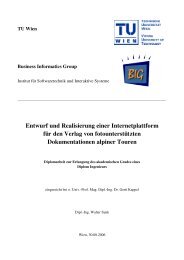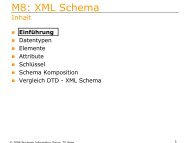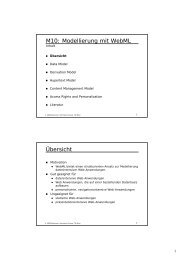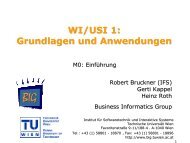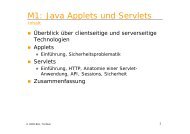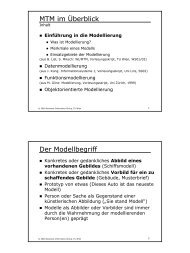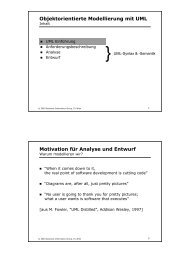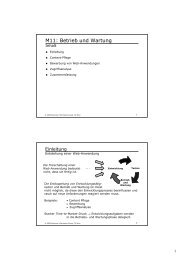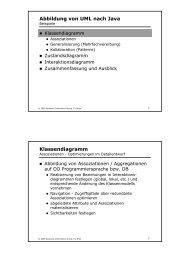Ph.D. Thesis - Business Informatics Group
Ph.D. Thesis - Business Informatics Group
Ph.D. Thesis - Business Informatics Group
You also want an ePaper? Increase the reach of your titles
YUMPU automatically turns print PDFs into web optimized ePapers that Google loves.
Chapter 1 Introduction<br />
elements of the target schema are not mapped, constraints of the target schema may<br />
be violated, e.g., if an unmapped attribute of the target schema is mandatory.<br />
• Single correspondences: For this class, the most important property of the correspondences<br />
is cardinality. According to the number of the participating elements in a correspondence,<br />
it can be distinguished between one-to-one, one-to-many, many-to-one, and<br />
many-to-many correspondences. On the instance level, one-to-one means that one element<br />
of the source model has exactly one corresponding element in the target model,<br />
one-to-many means that one element has to be splitted into several elements, manyto-one<br />
means that several elements have to be combined into one element, and manyto-many<br />
means a combination of one-to-many and many-to-one correspondences 4 .<br />
• Multiple correspondences: This class focuses on the structure of the source schema and<br />
the target schema. On the instance level this means, structurally related elements in<br />
the source model should also maintain their semantic relationship in the generated<br />
target model. Furthermore, this means, it should be possible to reproduce the original<br />
source model from the generated target model. For ensuring semantic preserving<br />
transformations, a set of single correspondences must be properly interpreted in combination<br />
with the structures of source schema and target schema.<br />
This thesis mainly deals with the two above mentioned kinds of heterogeneities, in the<br />
area of model engineering. As a consequence, heterogeneity issues have to be considered<br />
on higher levels of abstraction leading to the notions of meta-metamodel heterogeneity 5 at M3level<br />
and structural metamodel heterogeneities at M2-level.<br />
1.1.4 Model-based Tool Integration in the Context of the ModelCVS<br />
Project<br />
To tackle the previous mentioned problems of meta-metamodel heterogeneity and structural<br />
metamodel heterogeneity, we developed a system called ModelCVS aiming at providing<br />
a framework for model-based tool integration [KKK + 06b, KKR + 06]. ModelCVS enables<br />
transparent transformation of models between different tools’ languages and exchange formats<br />
going beyond existing low-level model transformation approaches.<br />
As can be seen in Figure 1.2, the proposed architecture of ModelCVS is organized into<br />
three major components. The red boxes represent tasks which are supported by tools and<br />
4 In practice, mostly all many-to-many correspondences can be reduced to a combination of one-to-many/manyto-one<br />
mappings. However, for specifying mappings, many-to-many mappings can at least provide a suitable<br />
mechanism to combine correspondences, thus reducing the size and enhancing the readability of a mapping<br />
model.<br />
5 Although MOF is the standardized meta-metamodel of the OMG, in practice other formats are also employed as<br />
6<br />
meta-metamodels.



